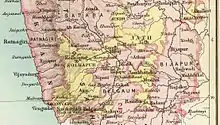Mudhol State
Mudhol State was a princely state during the British Raj. It was one of the former states of the Southern Maratha Country and its capital was the city of Mudhol in present-day Bagalkot District of Karnataka State in India. The last ruler was HH Shrimant Raja Bhairavsinhrao Malojirao Ghorpade II. Mudhol acceded to the Dominion of India on 8 March 1948, and is currently a part of Karnataka state.
| Mudhol State ಮುಧೋಳ ಸಂಸ್ಥಾನ | |||||||||
|---|---|---|---|---|---|---|---|---|---|
| Princely State of British India | |||||||||
| 1465–1948 | |||||||||
 Flag | |||||||||
 Mudhol State in the Imperial Gazetteer of India | |||||||||
| Area | |||||||||
• 1931 | 508 km2 (196 sq mi) | ||||||||
| Population | |||||||||
• 1931 | 936,218 | ||||||||
| History | |||||||||
• Established | 1465 | ||||||||
| 1948 | |||||||||
| |||||||||
| Today part of | Karnataka, India | ||||||||
| Official language: Kannada | |||||||||
Covering an area of 508 km2 (196 sq mi), Mudhol State enjoyed revenue estimated at £20,000 in 1901.[1] According to the 1901 census, the population was 63,001, with the population of the town itself at 8,359 in that year.[1]
History
The Mudhol jagir (estate) was founded ca 1400. Ruled by the Maratha Ghorpade dynasty. In 1670, Mudhol estate became a state. It became a British protectorate in 1819. The state flag, called 'Bavuta', was a triangular tricolour of horizontal bands, in order from the top: white, black and green. All colour bands came to the point in the fly. Mudhol State was one of the 9-gun salute states[2] of British India, under the summit of Niranjan.
Mudhol State's last king, HH Shrimant Raja Bhairavsinhrao Malojirao Ghorpade II, born 15 October 1929 and succeeded to the throne on 9 November 1937, was the 23rd Raja of Mudhol. He signed the accession to join the Indian Union on 8 March 1948.[3] He died in 1984 in a car accident.
Royal Titles
| Role | Royal Title |
|---|---|
| The Ruling Prince | Raja Shrimant (personal name) Raje Ghorpade Bahadur, Raja of Mudhol, with the style of His Highness |
| The Consort of the Ruling Prince | Shrimant Sakal Soubhagyavati Rani (personal name) Raje Ghorpade, Rani of Mudhol, with the style of Her Highness |
| The Heir Apparent | Yuvraj Shrimant (personal name) Raje Sahib Ghorpade |
| The sons of the ruling prince | Rajkumar Shrimant (personal name) Raje Ghorpade |
| The unmarried daughters of the ruling prince | Rajkumari Shrimant (personal name) Raje Ghorpade |
| The married daughters of the ruling prince | Shrimant Sakal Soubhagyavati (personal name) Raje (husband's family name) |
| The other male descendant of the ruling prince (male line) | Shrimant (personal name) Raje Ghorpade |
Rajas
- 1662 – 1700 Maloji Raje Ghorpade (d. 1700)
- 1700 – 1734 Sardar Akhayaji Raje Ghorpade (d. 1734)
- 1734 – 1737 Pirajirao Raje Ghorpade (d. 1737)
- 1737 – 1805 Malojirao III Raje Ghorpade (b. 1710 – d. 1805)
- 1805 – 1816 Narayanrao Raje Ghorpade (d. 1816)
- 1816 – 20 February 1818 Govindrao Raje Ghorpade (d. 1818)
- 20 Feb 1818 – Dec 1854 Vyankatrao I Raje Ghorpade (d. 1854)
- Dec 1854 – 27 March 1862 Balwantrao Raje Ghorpade (b. 1841 – d. 1862)
- 27 Mar 1862 – 19 June 1900 Vyankatrao II Raje Ghorpade (b. 1861 – d. 1900) "Bala Sahib"
- 27 Mar 1862 – 1882 .... -Regent
- 19 Jun 1900 – 14 November 1939 Malojirao IV Raje Ghorpade (b. 1884 – d. 1937) "Nana Sahib" (from 1 Jan *1920, Sir Malojirao IV Raje Ghorpade)
- 19 Jun 1900 – 1904 Council of Regency
- 14 Nov 1937 – 15 August 1947 Bhairavsinhrao Raje Ghorpade (b. 1929 – d. 1984)
- 14 Nov 1937 – 10 July 1947 Parvatidevi Raje Sahib – Ghorpade (f) -Regent
- 20 Oct 2006–present Raje Vikramsinha Gourishankar Ghorpade (b. 1986 – d. 1 May 2018 by Evo12) "Bala Sahib" (Sweet Prince)
Mudhol Hound
Shrimant Rajesaheb Malojirao Ghorpade of Mudhol (1884–1937) of the Mudhol State is credited with reviving the Mudhol hound. He noticed local tribal people using these hounds for hunting. Using selective breeding, he was able to restore the royal Mudhol hound. On a visit to England in the early 1900s, the Maharaja of Mudhol State presented King George V a pair of hounds, which popularized the Mudhol hound breed.[4][5]
References
- Chisholm, Hugh, ed. (1911). . Encyclopædia Britannica. 18 (11th ed.). Cambridge University Press. p. 955.
- "Archived copy". Archived from the original on 17 October 2007. Retrieved 31 May 2008.CS1 maint: archived copy as title (link)
- William Barton, The princes of India. Delhi 1983
- Jadeja, Arjunsinh (27 January 2015). "Tracking the hounds of Mudhol" (Bangalore). Deccan Herald. Retrieved 2 February 2015.
- Jadeja, Arjunsinh (23 July 2013). "Mudhol's royal chapter" (Bangalore). Deccan Herald. Retrieved 2 February 2015.